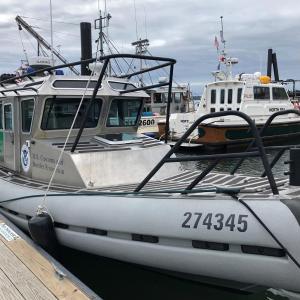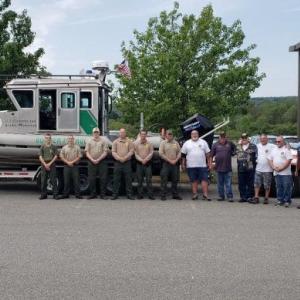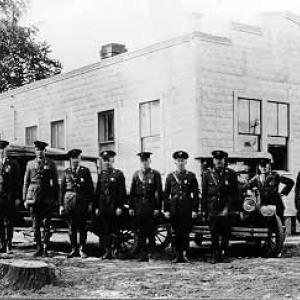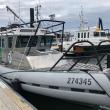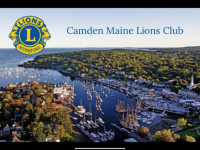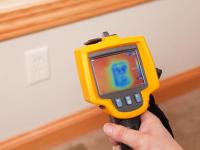U.S. Border Patrol heightens coastal waters presence on Penobscot Bay
 The U.S. Border Patrol vessel whose homeport is in Calais will be further south on patrols. (Photo courtesy U.S. Border Patrol)
The U.S. Border Patrol vessel whose homeport is in Calais will be further south on patrols. (Photo courtesy U.S. Border Patrol)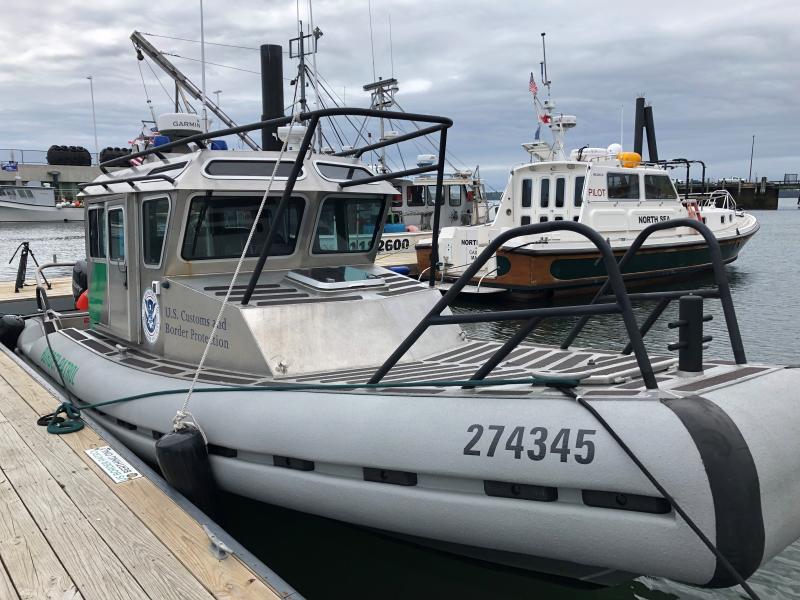 (Photo courtesy U.S. Border Patrol)
(Photo courtesy U.S. Border Patrol)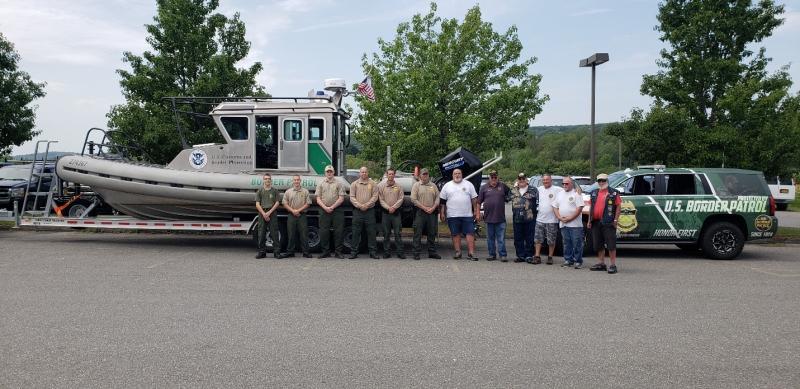 (Photo courtesy U.S. Border Patrol)
(Photo courtesy U.S. Border Patrol) The Houlton Border Patrol Sector's operational area includes the entire state. The patrol, established in 1924, consisted of 14 inspectors in Calais, Fort Fairfield, Fort Kent, Houlton, Jackman, Mars Hill, Van Buren and Vanceboro.
Houlton Patrol Inspectors enforced immigration laws, and apprehended liquor smugglers during the Prohibition. Inspectors also checked logging camps for illegal loggers from Canada. During World War II, agents assisted capturing escaped prisoners from the detention camp in Houlton.
In 1940, Houlton Sector opened stations in Bethel, Guilford, Fryeburg, Madison, Machias and Rangeley. They remained open until 1949 when a reorganization closed the stations as well as stations in Fort Fairfield, Fort Kent, Mars Hill and Vanceboro. In 1956, Fort Fairfield reopened and in 1957, a new station opened in Lincoln, and closed in 1978. In 1983 the Rangeley substation reopened.
Today, Houlton sector maintains stations in Calais, Fort Fairfield, Houlton, Jackman, Rangley and Van Buren.
The Houlton Border Patrol Sector's operational area includes the entire state. The patrol, established in 1924, consisted of 14 inspectors in Calais, Fort Fairfield, Fort Kent, Houlton, Jackman, Mars Hill, Van Buren and Vanceboro.
Houlton Patrol Inspectors enforced immigration laws, and apprehended liquor smugglers during the Prohibition. Inspectors also checked logging camps for illegal loggers from Canada. During World War II, agents assisted capturing escaped prisoners from the detention camp in Houlton.
In 1940, Houlton Sector opened stations in Bethel, Guilford, Fryeburg, Madison, Machias and Rangeley. They remained open until 1949 when a reorganization closed the stations as well as stations in Fort Fairfield, Fort Kent, Mars Hill and Vanceboro. In 1956, Fort Fairfield reopened and in 1957, a new station opened in Lincoln, and closed in 1978. In 1983 the Rangeley substation reopened.
Today, Houlton sector maintains stations in Calais, Fort Fairfield, Houlton, Jackman, Rangley and Van Buren.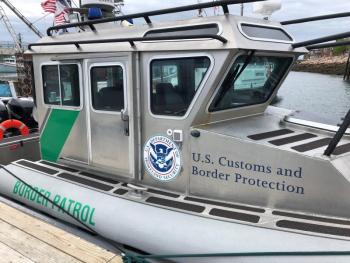 The U.S. Border Patrol vessel whose homeport is in Calais will be further south on patrols. (Photo courtesy U.S. Border Patrol)
The U.S. Border Patrol vessel whose homeport is in Calais will be further south on patrols. (Photo courtesy U.S. Border Patrol)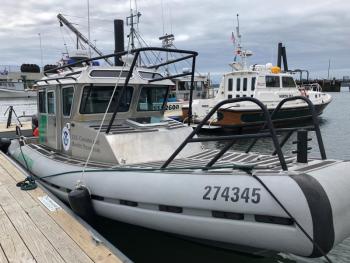 (Photo courtesy U.S. Border Patrol)
(Photo courtesy U.S. Border Patrol)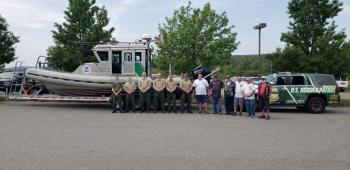 (Photo courtesy U.S. Border Patrol)
(Photo courtesy U.S. Border Patrol)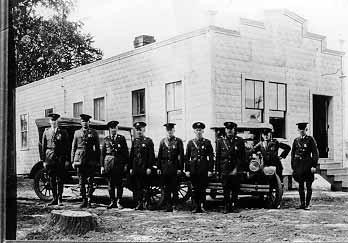 The Houlton Border Patrol Sector's operational area includes the entire state. The patrol, established in 1924, consisted of 14 inspectors in Calais, Fort Fairfield, Fort Kent, Houlton, Jackman, Mars Hill, Van Buren and Vanceboro.
Houlton Patrol Inspectors enforced immigration laws, and apprehended liquor smugglers during the Prohibition. Inspectors also checked logging camps for illegal loggers from Canada. During World War II, agents assisted capturing escaped prisoners from the detention camp in Houlton.
In 1940, Houlton Sector opened stations in Bethel, Guilford, Fryeburg, Madison, Machias and Rangeley. They remained open until 1949 when a reorganization closed the stations as well as stations in Fort Fairfield, Fort Kent, Mars Hill and Vanceboro. In 1956, Fort Fairfield reopened and in 1957, a new station opened in Lincoln, and closed in 1978. In 1983 the Rangeley substation reopened.
Today, Houlton sector maintains stations in Calais, Fort Fairfield, Houlton, Jackman, Rangley and Van Buren.
The Houlton Border Patrol Sector's operational area includes the entire state. The patrol, established in 1924, consisted of 14 inspectors in Calais, Fort Fairfield, Fort Kent, Houlton, Jackman, Mars Hill, Van Buren and Vanceboro.
Houlton Patrol Inspectors enforced immigration laws, and apprehended liquor smugglers during the Prohibition. Inspectors also checked logging camps for illegal loggers from Canada. During World War II, agents assisted capturing escaped prisoners from the detention camp in Houlton.
In 1940, Houlton Sector opened stations in Bethel, Guilford, Fryeburg, Madison, Machias and Rangeley. They remained open until 1949 when a reorganization closed the stations as well as stations in Fort Fairfield, Fort Kent, Mars Hill and Vanceboro. In 1956, Fort Fairfield reopened and in 1957, a new station opened in Lincoln, and closed in 1978. In 1983 the Rangeley substation reopened.
Today, Houlton sector maintains stations in Calais, Fort Fairfield, Houlton, Jackman, Rangley and Van Buren.ROCKLAND — The U.S. Border Patrol, which Mainers usually consider an agency encountered when crossing the Calais or Houlton border to Canada, is making periodic visits to the state’s coastal waters, including Penobscot Bay.
The work of the armed crew aboard the 27-foot vessel is to conduct patrols and address “illicit or illegal trade,” according to Border Patrol spokesman,Michael S. McCarthy, who is stationed at the agency’s Office of Public Affairs, U.S. Customs and Border Protection, in Boston.
“This is still a border,” said McCarthy, in an Aug. 8 phone conversation, explaining why the border patrol will be on Maine’s coastal waters down this far from the Canadian border.
McCarthy has been reaching out to local media to better illuminate the federal agency’s Midcoast presence to the public.
The border patrol vessel had been riding on a trailer on the Aug. 3 annual Lobster Festival parade, and on Aug. 7, a news release was issued to local media.
“The Border Patrol agents—veterans of the United States Navy and United States Marine Corp—traveled from around the state to participate in Saturday’s event,” the release said. “They brought with them a 27-foot patrol vessel, assigned to the Calais Border Patrol Station and several members of the Border Patrol Explorers Post 1820 in Houlton.”
The release continued: “Rockland and all of the Midcoast region fall under the Calais Border Patrol Station’s area of operations. Although the Border Patrol does not maintain a permanent facility in the Midcoast area, agents do conduct routine maritime patrols in and around Penobscot Bay.
“We place a high value on our community involvement and always look to be involved around the State of Maine,” said Jason D. Owens, Chief Patrol Agent of the Border Patrol in Maine. “We certainly thank Winslow- Holbrook- Merritt Post 1 for hosting us and providing an opportunity for our agents and Explorers to be involved in the annual parade and the post-parade event.”
The U.S. Border Patrol, said McCarthy, falls under the federal Homeland Security umbrella, as does the U.S. Coast Guard, and others.
“It is different from ICE,” he said.
That agency’s mission is: “United States Immigration and Customs Enforcement (ICE) promotes homeland security and public safety through the criminal and civil enforcement of federal laws governing border control, customs, trade, and immigration.”
“These are not immigration raids,” he said, describing what the Border Patrol water-based crews will be doing.
The U.S. maritime border extends 24 miles offshore. That zone is where the U.S. or Maine may exercise and enforce international and state maritime law.
In 1799, the U.S. Congress passed legislation to allow boarding of foreign flag vessels within 12 nautical miles,” according to the National Oceanic and Atmospheric Association (NOAA) Maritime Limits white paper. This zone was known as “customs waters” and was later called the ‘contiguous zone.’ In 1999, President Clinton by Proclamation extended the U.S. contiguous zone to 24 nautical miles.
While the Border Patrol vessel has a homeport of Calais, it does travel via trailer or water to an office in Rockland, where it shares dock space with the U.S. Coast Guard Station Rockland.
The patrol aboard the vessel have the right to pull up alongside any vessel and conduct a “consensual conversation,” said McCarthy.
That conversation can be focused on “what are you doing today,” to “some may arouse suspicion.”
The goal, he reiterated, is to stop illicit trades, smuggling, and human smuggling.
The Border Patrol, at its website, said: “One of the most important activities of a Border Patrol agent is line watch. This involves the detection, prevention and apprehension of terrorists, undocumented aliens and smugglers of aliens at or near the land border by maintaining surveillance from a covert position, following up leads, responding to electronic sensor television systems, aircraft sightings, and interpreting and following tracks, marks and other physical evidence. Some of the major activities are traffic check, traffic observation, city patrol, transportation check, administrative, intelligence, and anti-smuggling activities.”
Agents are armed, he said. Their schedules, and when they may be patrolling waters southwest of Calais are not made public. The vessel is a smaller version of the Border Patrol’s 33-foot Interceptor Class.
Reach Editorial Director Lynda Clancy at lyndaclancy@penbaypilot.com; 207-706-6657
Event Date
Address
United States


